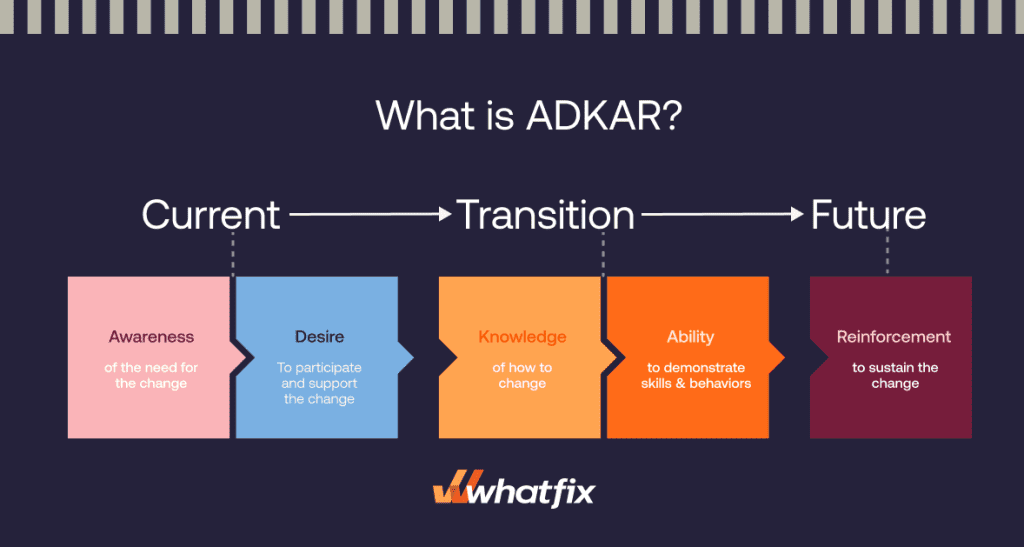ADKAR Model: What Is It and How To Use It?
- Published:
- Updated: July 16, 2024

The ADKAR model for change management is based on a simple principle — organizational change can only happen when individuals change.
Organizational change often fails because while employees know a change is happening, they don’t understand why it’s occurring. This may be due to a lack of trust, poor change management strategies, or not enabling employees with the right training and support to navigate the change.
The ADKAR model eliminates these problems by equipping leaders with the right strategy, employees with the necessary information, and the right motivation to navigate organizational changes successfully.
While breaking out the ADKAR acronym into its five outcomes is simple, successfully applying this popular change management model requires a deeper understanding of how to achieve each individual outcome.
What Is the ADKAR Model?
The ADKAR Model of Change Management is an outcome-oriented change management method that aims to limit resistance to organizational change. Created by Jeffrey Hiatt, the founder of Prosci, ADKAR is one of two official Prosci change management methodologies.

What Does ADKAR Stand For?
- Awareness of the need for change
- Desire to participate and support the change
- Knowledge of how to change
- Ability to implement desired skills and behaviors
- Reinforcement to sustain the change
Per the ADKAR change management model, awareness and desire aim to move you out of the current state, where change is needed but has not yet begun. Knowledge and ability occur during the transition, and reinforcement focuses on the future.

A corporate example of the ADKAR model in practice
If you’re wondering whether a change management model proposed in 2003 still holds true today – here’s an example from Microsoft that has used the ADKAR model recently.
Jean Claude Monney, Microsoft Services, had an “aha” moment when he realized that organizational change was impossible without people changing.
“I started with Kotter’s change model, and I think the fundamentals are still valid. But when the rubber hits the road, it’s the last part, the last mile, we didn’t have a proven method for. The ADKAR Model gives that last mile that makes or breaks (when you don’t use it) the whole program. In a world that is moving to agile as a business strategy, not agile only in the software sense, an individual change model is mandatory.” (Source)
Jean first turned to ADKAR when Microsoft needed to reimage its knowledge collaboration platform on the cloud and make it a showcase for the organization.
Today, even the Microsoft Customer Success teams use the ADKAR model to influence buy-in and identify blockers to customer success and adoption.
How to Apply the ADKAR Model For Organizational Change
Since the ADKAR Model is outcome-oriented, it can facilitate change by setting clear milestones to be reached throughout the process. Every person involved in the change must reach each goal, though different people may get other goals at different times. For example, one person may already desire to change, while another is still becoming aware of the need to change.
One of the most helpful aspects of the ADKAR Model is that its five sequential goals identify resistance areas.
For instance, is someone unable to change because they do not understand why it needs to happen (Awareness), or do they not understand how to make the change (Knowledge)? You will be better prepared to guide them through a stage once you figure out which step someone is stuck on.
GOAL 1: Create awareness of the need to change.
Communicating the need for change is fundamental. But creating awareness for the change goes beyond simply announcing it. In order for employees to be truly aware of the necessity for change, they must not only understand the reasoning behind it but also come to agree with that reasoning.
Begin by providing clear explanations of why the change is needed.
Let’s say you’re introducing Microsoft Sharepoint. Start by explaining that when employees travel or work from home, it’s difficult for them to access documents and communicate with the in-office team. To solve this problem, the company will use Microsoft’s SharePoint cloud-based service.
Be sure to focus on the benefits of the change as they apply to the people affected. In this case, SharePoint will allow off-site workers to access documents and data easily. Making the switch will streamline communication and eliminate information silos.
Always encourage your team to ask questions about how you decided on the change and how it will be implemented, and about other aspects of the change process plan.
GOAL 2: Foster desire to make the change
Just because employees understand why a change should be made doesn’t mean they want that change. In order for them to adopt the change, they must desire it. Thankfully, you can foster that desire.
Start by designating change leaders. Not only will your change leaders show public support for the change, but they most naturally connect with the people who will be affected by it. Choose change leaders who are able to relate to how daily routines will be affected so that they can provide specific support and guidance.
In order to foster desire, change leaders need to get specific about the benefits of the change as they apply to particular individuals or teams. Avoid touting advantages for the company.
You may want to replace three separate tools with Salesforce because it saves you money, but that’s not a great motivator for employees. Instead, present the change as something that will benefit them in their day-to-day work lives. In this case, Salesforce will make it easier for them to run reports, monitor customer relationships, and implement marketing strategies all in one place, saving them the trouble of using three different tools.
When fostering desire, resistance to change is a major obstacle. Resistance is to be expected, but you need to understand the core reason for it. Are people scared that they don’t have the skills to make the change? Is that they are worried about how it will affect their job duties? Are employees frustrated by the extra effort needed to learn something new?
Once you understand the root cause of the resistance, address it head-on and, if necessary, make adjustments to your change implementation plan.
✓ Thank you, the template will be sent to your email
Goal 3: Provide knowledge on how to change
The knowledge milestone in the ADKAR Model is primarily refers to training and education. In order to begin the transition, your team will need to understand how their responsibilities, skills, tools, and processes will be impacted.
Given that everyone must reach each milestone individually, knowledge-building needs to be specific. Provide knowledge that applies directly to each team’s or individual’s responsibilities.
For example, if you are introducing new software, the IT team may be responsible for setting everyone up to use it, while other departments will need to focus more on how to use the software. The knowledge needed to perform distinct roles in the change is different even though the overall change may be the same.
Take time to evaluate what additional skills, tools, and duties the change will require. You should also share a force field analysis so employees understand what forces are preventing change and how to counteract these forces. Doing so will allow you to plan your change schedule around the necessary skill development.
And remember: Too much change all at once can be jarring and lead to resistance. If your change requires employees to learn a large amount of new material and/or master new skills, implement the change gradually.
Another way to increase comprehension is to use a variety of creative employee training methods:
- Traditional classroom training
- Job shadowing/mentoring
- Videos
- Blog series
- Interactive self-guided learning
Of course, knowledge-building should go beyond facilitating the change. It is equally important to provide knowledge that allows your team to see the change through to the end.
Goal 4: Ensure that employees have the ability to make the change
Regardless of how well employees know how to do something, having confidence in their own competencies determines whether or not they can or even will do something.

The Prosci change management methodology uses athletics to prove this point: While plenty of baseball fans understand the mechanics behind throwing a curveball, not all of them would make great pitchers.
To bridge the gap between knowledge and ability, put change leaders in charge of coaching individuals or teams. Task change leaders with collecting feedback from their teams and bringing potential issues and obstacles to your attention.
Hands-on training is also precious. By allowing teams to test the change before fully rolling it out, you will enable them to build confidence. Plus, you can monitor performance and provide detailed feedback. For larger-scale changes, consider implementing them in stages so you can identify issues early on and make adjustments to your implementation plan.
Goal 5: Reinforce the change
Initial momentum may get you to the finish line, but you won’t cross it if employees start relying on old habits.
Once new processes are in place, new software is installed, or the new organizational chart is official, reinforce the change long after its implementation.
Celebrate success during and after the transformation so that you can build and maintain enthusiasm. Try creative motivation techniques like these:
- Zendesk’s Champagne Campaign, which involves setting small goals for employees and then recognizing the success by placing a small bottle of champagne on their desks
- iDoneThis’s weekly show-and-tell video call, which provides an opportunity for employees to share what they are proud of accomplishing
Correct mistakes and poor behavior in private when people slip back into old habits. On the other hand, give praise publicly so that the entire organization can celebrate together.
In the meantime, continue to collect feedback. The change process may be “complete,” but employee feedback is still valuable. Listen to employees to identify pain points and see where extra support would be beneficial.
Lastly, include time for reinforcement in your change management plan. You should continue monitoring and reinforcing the change all through Q4 if you intend to be fully switched over to SharePoint by the end of Q3. Change cannot be solidified overnight; reinforcement efforts should go well beyond the target completion date.
The ADKAR model provides an excellent framework for many types of organizational change. However, that doesn’t mean you should depend solely on the ADKAR change management methodology. Each milestone may require additional support from change leaders, change management software, and employees, so seek that support.
You may also consider combining the ADKAR model with other established change management models. In order to have a framework to handle emotional reactions, the ADKAR model could be paired with people-centric methods.
Change takes time, but Whatfix can help accelerate transformations.
Contact Whatfix to discuss how we can help build knowledge, increase ability, and reinforce changes through our customized self-guided learning and digital adoption tools.
Software clicks better with Whatfix's digital adoption platform
Enable your employees with in-app guidance, self-help support, process changes alerts, pop-ups for department announcements, and field validations to improve data accuracy.
ADKAR Model
FAQs
Who uses the ADKAR model?
The Prosci model has been successfully implemented by organizations across verticals namely Microsoft, Avnet, and the Colorado government.
What are the pros and cons of ADKAR?
Pros:
- Practical approach instead of theoretical
- Has been extensively tested and is widely used
- There is lots of training and support available
Cons:
- The process may be complicated
- May be more suited to larger organizations
- The model doesn’t take into account how complex some changes can be
Which of the five ADKAR steps is the most challenging?
Desire is often identified as the biggest blocker since it’s ultimately a personal decision to get on board with an organizational change. While decisions can be swayed, no one can make someone have the desire to support changes.
Is the ADKAR model linear?
While the steps of the ADKAR change management framework are sequential, you can go back and forth between the steps, making it a non-linear process.
Which model is better ADKAR or Kotter?
If you’re confused between the ADKAR and Kotter models, the answer lies in what you’re trying to change. If you want to motivate individuals to change, ADKAR is your best bet. While the target of Kotter’s change leadership is drive enterprise-wide change. You can incorporate both models in your organization depending on your goals.
Which management model is best?
Some of the most popular change management models are ADKAR, Lewin’s, Kotter’s and Kübler-Ross – all of which you can find more details on here. You may choose to use one or more depending on the complexity of change, your goals and targets.
Request a demo to see how Whatfix empowers organizations to improve end-user adoption and provide on-demand customer support
Thank you for subscribing!


